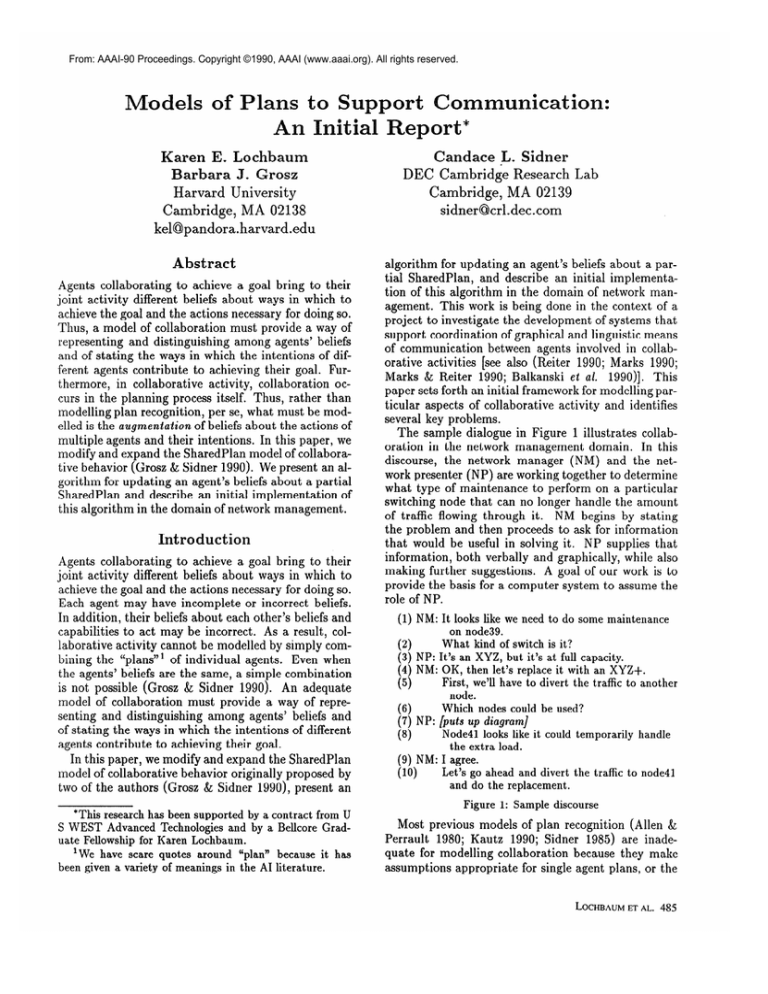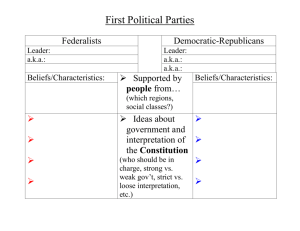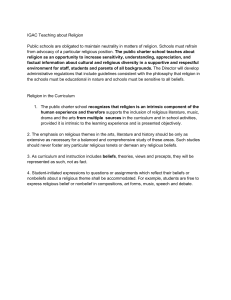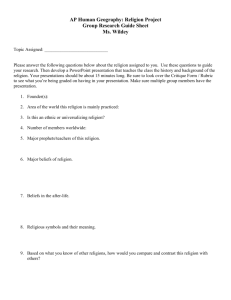
From: AAAI-90 Proceedings. Copyright ©1990, AAAI (www.aaai.org). All rights reserved.
Models
of Plans to Sup
nitial Rer,ort*
Karen E. Lochbaum
Barbara J. Grosz
Harvard University
Cambridge, MA 02138
kel@pandora.harvard.edu
Abstract
Agents collaborating to achieve a goal bring to their
joint activity different beliefs about ways in which to
achieve the goal and the actions necessary for doing so.
Thus, a model of collaboration must provide a way of
representing and distinguishing among agents’ beliefs
and of stating the ways in which the intentions of different agents contribute to achieving their goal. Furthermore, in collaborative activity, collaboration occurs in the planning process itself. Thus, rather than
modelling plan recognition, per se, what must be modelled is the augmentation of beliefs about the actions of
multiple agents and their intentions. In this paper, we
modify and expand the SharedPlan model of collaborative behavior (Grosz & Sidner 1990). We present an algorithm for updating an agent’s beliefs about a partial
SharedPlan and describe an initial implementation of
this algorithm in the domain of network management.
Introduction
Agents collaborating to achieve a goal bring to their
joint activity different beliefs about ways in which to
achieve the goal and the actions necessary for doing so.
Each agent may have incomplete or incorrect beliefs.
In addition, their beliefs about each other’s beliefs and
capabilities to act may be incorrect. As a result, collaborative activity cannot be modelled by simply combining the “plans” ’ of individual agents. Even when
the agents’ beliefs are the same, a simple combination
is not possible (Grosz & Sidner 1990). An adequate
model of collaboration must provide a way of representing and distinguishing among agents’ beliefs and
of stating the ways in which the intentions of different
agents contribute to achieving their goal.
In this paper, we modify and expand the SharedPlan
model of collaborative behavior originally proposed by
two of the authors (Grosz & Sidner 1990), present an
municat ion:
Candace .L. Sidner
DEC Cambridge Research Lab
Cambridge, MA 02139
sidner@crl.dec.com
algorithm for updating an agent’s beliefs about a partial SharedPlan, and describe an initial implementation of this algorithm in the domain of network management. This work is being done in the context of a
project to investigate the development of systems that
support coordination of graphical and linguistic means
of communication between agents involved in collaborative activities [see also (Reiter 1990; Marks 1990;
Marks & Reiter 1990; Balkanski et al. 1990)]. This
paper sets forth an initial framework for modelling particular aspects of collaborative activity and identifies
several key problems.
The sample dialogue in Figure 1 illustrates collaboration in the network management domain. In this
discourse, the network manager (NM) and the network presenter (NP) are working together to determine
what type of maintenance to perform on a particular
switching node that can no longer handle the amount
of traffic flowing through it. NM begins by stating
the problem and then proceeds to ask for information
that would be useful in solving it. NP supplies that
information, both verbally and graphically, while also
making further suggestions. A goal of our work is to
provide the basis for a computer system to assume the
role of NP.
(1) NM: It looks lik e we need to do some maintenance
on node39.
What kind of switch is it?
(2)
(3) NP: It’s an XYZ, but it’s at full capacity.
(4) NM: OK, then let’s replace it with an XYZ+.
First, we’ll have to divert the traffic to another
(5)
node.
Which nodes could be used?
(6)
(7) NP: [puts up diagram]
Node41 looks like it could temporarily
(8)
the extra load.
(9) NM: I agree.
Let’s go ahead and divert
(10)
and do the replacement.
Figure
*This research has been supported
by a contract from U
S WEST
Advanced
Technologies
and by a Bellcore Graduate Fellowship for Karen Lochbaum.
‘We have scare quotes around “plan” because it has
been given a variety
of meanings
in the AI literature.
1: Sample
the traffic
handle
to node41
discourse
Most previous models of plan recognition (Allen &
Perrault 1980; Kautz 1990; Sidner 1985) are inadequate for modelling collaboration because they make
assumptions appropriate for single agent plans, or the
LOCHBAUMETAL.
485
plans of multiple independent agents, but not for the
plans of collaborating agents. These assumptions include a data-structure model of plans as well as a
master/slave relationship between all-knowing agents.
In particular, these models treat plans as sequences
of steps to be performed; as each step occurs, it is
filled into a particular plan schema. These models
also assume that one agent, the speaker, is a controlling agent, while the other agent, the hearer, is simply
a reactive agent, inferring and cooperating with the
plan of the speaker. Because the hearer and speaker
are assumed to have the same complete and correct
knowledge of the domain, the systems do not distinguish between the speaker’s and hearer’s beliefs about
actions.
Pollack, in modelling how an inferring agent reasons
about another agent’s invalid plans, differentiates each
agent’s individual beliefs and intentions regarding actions and the relations among them from other agents’
(Pollack 1986; Pollack 1990). Her model thus provides
a useful base on which to define a model of collaborative activity. However, she also makes the assumptions that the inferring agent has complete and accurate knowledge of domain actions and that that agent
is recognizing the plans of another. In collaborative
activity, collaboration occurs in the planning process
itself. Thus, rather than modelling plan recognition,
per se, what must be modelled is the augmentation of
beliefs about the actions of multiple agents and their
intentions.
In the next section, we present the modified definition of SharedPlan and describe two new constructs:
recipes and the Contributes relation. We then present
an augmentation algorithm and give examples of its
use. Finally, we describe future directions of this work.
1990)3. Act-type relations include generation [CGEN
(Pollack 1986; Pollack 1990)] and enablement. In addition, complex act-types, for example, ones involving
sequences of acts or simultaneous acts, may be built
from simpler ones using act-type constructor functions
(Balkanski et al. 1990).
Two agents, G1 and G2, are said to have a SharedPlan during time Tl to accomplish an action of type
A during time T2 if and only if they hold the beliefs
and intentions listed below:
SharedPlan(G1,G2,A,Tl,T2)
1. MB(G1,G,EXEC(
_
(q ,Gaj ,Ta,)),Tl)
2. MB(G1 ,Gz,R:recipe-for-A,Tl)
3. MB(GI,G~,INT(G,~,(~~,G~~,T~~),T~),T~)
4. MB(G1 ,G2,INT(G,j,(aj
Contributes((ai,
,G, .>T,j)A
Gaj, TQjS, A), Tl), Tl)
5. INT( G,j 9(ai >Gaj ,T,j) ,Tl)
6. INT(G,j
> (aj ,Gaj >Taj) A
Contributes((aj, Gai, Taj)r A), 7’1)
The definition of SharedPlan follows Pollack’s work on
single agent plans (Pollack 1986; Pollack 1990) in taking the notion of “having a plan” to be central and
to consist of being in a certain mental state, namely,
holding certain beliefs and intentions regarding acts
and their executability. This stance differs from other
work in planning which takes a plan to be a data structure encoding a sequence of actions. The mental state
view is crucial to the ability to model plans constructed
and carried out collaboratively.
SharedPlans are defined in terms of act-types and
relations among them. We distinguish types of actions, act-types (or acts), from individual tokens of
the type (for which we will use the term action). An
act-type is a triple, (y(P1.. . Pn),G,T), where the Pi
are parameters of the activity y(Pi.. . P,)2, G is the
agent who performs the activity, and T the time interval over which the activity occurs (Balkanski et al.
In this definition, the index j ranges over the act-types
in the recipe R for doing A. For each oj, Gaj denotes
the agent who performs the activity, and Taj denotes
the time interval over which the activity is performed.
Each TYj is a subinterval of T2 which is the interval
over which A is performed. The predicate MB holds of
two agents, a proposition, and a time just in case the
two agents mutually believe the proposition over the
time interval. The predicate INT holds of an agent, an
act-type, and a time if the agent intends to perform
an action of that type during the time interval. EXEC
holds if the agent is able to perform an action of the
appropriate type (Pollack 1990).
This definition provides a framework in which to further evaluate and explore the roles that particular beliefs and intentions play in collaborative activity. Currently, the definition only provides for recipes in which
each constituent act is performed by one of two agents.
However, we are currently investigating act-types performed by multiple agents (i.e. Gaj is a set of agents)
and extensions of the definitions of INT and EXEC to
multiple agents.
The two most complex portions of the definition of
SharedPlans are the recipe-for-A in Clause (2) and the
Contributes relation in Clauses (4) and (6). Recipes
were not part of the original SharedPlan definition
(Grosz & Sidner 1990) and Contributes was only informally defined; both of these are discussed in more
detail below.
SharedPlans are constructed incrementally. When
agents Gi and G2 have some partial set of beliefs and
intentions from the SharedPlan definition (or even simply have a mutual desire to achieve a SharedPlan),
but have not yet completed the building of such a
2When the parameters of an activity are not at issue,
we will simply use the activity name, y, as an abbreviation
for y(P1.. . P,).
3We follow the Prolog convention of specifying variables
using initial uppercase letters and constants using initial
lowercase letters.
Definition
486
INTELLIGENTINTERFACES
of SharedPlan
plan, they are considered to have a partial SharedPlan,
which we will denote by SharedPZan*. Each utterance
of a discourse contributes some information about beliefs and intentions to this evolving jointly-held plan.
As opposed to a SharedPlan*, a SharedPlan for a particular A specifies all of the beliefs and intentions necessary for performing A. It is not necessary, however,
for the SharedPlan to be fully specified before any actions may take place. On the contrary, performance
of actions may be interleaved with discussion of those
and other actions.
Recipes
Following Pollack (Pollack 1990), we use the term
recipe to refer to what agents know when they know
a way of doing something. Clause (2) of the SharedPlan definition thus states that when agents have a
SharedPlan for doing some act, they must hold mutual beliefs about the way in which to perform that
act. Recipes are specified at a particular level of detail.
Hence, Clause (2) only requires the agents to have mutual beliefs about acts specified at the particular level
of detail of the recipe and does not require them to
have mutual beliefs about all levels of acts that each
agent will perform. In our earlier work (Grosz & Sidner
1990), we considered only simple recipes; each recipe
consisted of only a single act-type relation. However,
for any interesting activity, recipes include many different types of relations.
Recipes, more formally stated, are aggregations of
act-types and relations among them. Act-types, rather
than actions, are the main elements in recipes because
the regularities about which agents can have beliefs
must necessarily be stated in terms of types and not
tokens. A recipe for performing a particular act, F4,
encodes constraints on constituent acts and their interrelationships. Performing all of the constituent acts
in the recipe, following any ordering stipulated by the
act-type relations, will result in the performance of I’.
Figure 2 contains two sample recipes from the network management domain. Recipe1 indicates that one
way to upgrade a particular switching node, subject to
conditions, C,, , is to replace the node by a new node
of a different type; i.e. CGEN(( replace-switch(N:node,
S:switch-type),
Gl, Tl),
(upgrade(N:node),
Gl, Tl),
C,,j5. However, before that can be done, the switch
traffic must be diverted to another node. According
to Recipe2, a node may be upgraded by adding more
capacity to it; however, there is a generation-enabling
condition on this relation which requires that the node
still have room for more capacity.
4 When the specific components of an act-type are not at
issue, we will abbreviate the triple by using capital Greek
letters.
5We assume a typed logic in which X:type is used to
indicate the type of object that may replace the variable
X. For presentation purposes, the types have been omitted
from Figure 2.
Recipe2
Recipe1
(wra~e~l$W’l)
(replaceswitch(f,S),Gl,Tl)
fr
(uwade(N),GT)
t %t-wv
(add-capacity(N),G,T)
(moveDtraffic(N,D),G2,T2)
tc indicates generation subject to the condition c
fi indicates enablement
Figure 2: Two network management recipes
Note that the act-types in these recipes are specified
at a fairly high level of detail. For example, although
the activity move-trafic
is further decomposable into
activities involving flipping specific switches, such lowlevel details are not part of this recipe. They may,
of course, be part of a recipe for move-trafic
itself.
For example, this more detailed level is necessary for
a situation in which a new operator is being taught
exactly how to move traffic around a network.
RecipeI may be used to upgrade any node, but
Recipe2 may only be used for types of switches that
allow some additional capacity to be added. This condition on applicability of recipes may be modelled by
associating recipes with elements of an act-type lattice
(Balkanski et al. 1990). In such a lattice, act-types are
partially ordered according to specialization - more
specialized act-types lie below their abstractions. For
example, such a lattice might contain the act-types
(upgrade(N:node),
G, T), ( upgrade(N:node-typel),
G, T) ,
and (upgrade(N:node-type,?),
G, T), where the second
and third act-types are specializations of the first. The
parameter type specialization of node to node-type1
or node-type2 corresponds to the distinction made
by the recipes in Figure 2; switches of node-type2
allow the addition of extra capacity while switches
of node-type1 do not. Thus, Recipe1 is associated
with the lattice element (upgrade(N:node-typel),
G, 7’),
while both Recipe1 and Recipe2 are associated with
(upgrade(N:nodeAype2),
G, 13. The distinction made
in the use of these two recipes is not modeled in the
recipes themselves, but is a consequence of the association of recipes with lattice elements.
Upon completion of a SharedPlan, the recipe-for-A
in Clause (2) of the definition will be of the same form
as the recipes in Figure 2. During the construction
of a SharedPlan, however, the agents are establishing
mutual beliefs about act-types relevant to performing
A. Thus, at any time during this construction, the
recipe-for-A of Clause (2) is only partially specified.
Contributes
Agents’ beliefs about recipes may be partial in a number of different ways. Not only might an agent not
know all of the act-types involved in performing A,
but he might not know the exact relations that hold
between the act-types. For example, Jack may believe that to replace his oil filter, he has to find
the drain plug on his oil pan (perhaps because his
LOCHBAUMETAL.
487
friend Carol, who believes that it’s good practice to
always change your oil and filter together, told him
so), but he may not know the specific act-type relations that hold between finding the plug and replacing the filter (e.g. enable((find(P:drain-plug),
G, Tl),
(remove(P:drainqlug),
G, T2)), . . .).
The Contributes
relation used in Clauses (4) and (6) of the SharedPlan
definition is a general act-type relation intended to capture this level of knowledge. Thus, Jack’s beliefs about
replacing his filter, would include an act-type relation
of the form, Contributes((find(P:drain-plug),
G, Tl),
(replace(F:oiLfilter),
G, T3)).
Contributes is defined as the transitive closure of the
D-Contributes relation where D-Contributes depends
upon the act-type relations and constructors defined
in (Balkanski et al. 1990) and is defined as follows:6
D-Contributes
(I’, A) s
1. P(C A)
where p is one of the primitive act-type
relations: generate,enable, facilitate, . . .
OR
2. A = ~(l?r, F2,. . . , F,), such that I? = Fj for
somej,l<jLn,and
K is one of the act-type constructor functions:
sequence, simult, conjoined, or iteration.
That is, D-Contributes holds between act-types I? and
A, when I’ stands directly in an act-type relation p to
A or when I’ is a direct component of A.
The Contributes relation is used in Clauses (4) and
(6) of the SharedPl an definition as a modifier indicating the way in which an act-type is performed. That is,
INT(G~j,(~j,G~j,T~j)
A Contributes((cuj,G,j,T,j),
A), Tl) means that Gaj intends to do the activity oj
as a way of contributing to A (cf. Pollack’s act-type
constructor by (Pollack 1986; Pollack 1990)). Such a
construction is meant to capture the notion that oj is
only being done as a way to achieve A, and hence failures related to it constrain replanning (Bratman 1990).
SharedPlan
Augmentation
The process of augmenting a SharedPlan* comprises
the adoption of mutual beliefs and intentions related to
the clauses of the SharedPlan definition. Such beliefs
include those about acts in the recipe of the plan, properties of those acts, and intentions to perform them. A
SharedPlan* may thus be affected by utterances containing a variety of information.
An individual utterance, however, can only convey information about
the beliefs or intentions of the speaker of that utterance. Thus, the algorithm for updating a SharedPlan*
includes mechanisms for attributing individual beliefs
and intentions and subsequently establishing mutual
6We assume a theory of mutual belief that allows for
a Contributes relationship without necessitating
explicit beliefs about aI of the supporting D-Contributes
relationships.
belief of
488
INTELLIGENT~TERFACES
beliefs based on those individual attitudes and on the
discourse and SharedPlan contexts in which the utterance occurs.
The basic algorithm for updating a partial SharedPlan on the basis of information contained in an utterance of a dialogue carried out in support of collaborative activity is given below. Ga and Gj denote the
two agents, Gr and G 2. Gi denotes the speaker of the
utterance and Gj the other participant. The algorithm
given is for Gj ; Gi’s differs in some details, e.g. Gi already knows his beliefs about recipes whereas Gj must
infer new ones to attribute to Gi. AActProp is used to
denote the proposition (Prop) expressed in the current
utterance, where Act indicates the particular act to
which it refers. To simplify the discussion, we will ignore the details of the information about Act that Prop
represents. Utterances (4) through (6) of the dialogue
in Figure 1 illustrate the variety of such propositions
that utterances may contain.
SharedPlan
Augmentation
Algorithm:
Assume:
Act is an action of type I?,
Gd designates the agent who communicates
AA&Prop,
Gj designates the other agent,
SharedPlan*(Gr, G2, A, Tl, T2).
1. As a result of the communication, assert
MB(Gr,G2,BEL(Gi,AActSrop)).
2. Search own beliefs for BEL(Gj ,AActProp).
3. Ascribe BEL(Gi ,Contributes(I’,A)).
4. Search own beliefs for Contributes(I’,A)
and
where possible, more specific information as to
how I? contributes to A.
5. If Steps (2) and (4) are successful, signal assent
and MB(Gr ,G2,Contributes(F,A))7.
6. If Step(2) or Step (4) is unsuccessful then
query Gi or communicate dissent.
Each agent brings to the joint activity private beliefs and intentions. As these private attitudes are
communicated, they participate in the agents’ having
a SharedPlan. Steps (3) and (4) reflect this behavior. Namely, Gj , based upon Gi’s utterance, ascribes
beliefs to Gi and then searches his own beliefs with respect to Gi’s. Taking “having a plan” to mean having
a set of beliefs and intentions about an act is crucial
to these steps. The interleaving of the ascription of
private plans and of SharedPlans would be much more
difficult if plans were taken to be data structures.
The Contributes relation also plays an important
role in the ascription process in that it supports partiality during the construction of plans. Without this
general relation, plan ascription would have to assert
that some much stronger relationship held, one which
would not necessarily be supportable (e.g. if information relevant to establishing it were unavailable). Furthermore, when two agents have different recipes for
7Gj may, of course,
suggest
alternatives.
achieving a goal, and are not initially aware of these
differences, use of the Contributes relation is critical
( see the second example below). If the inferring agent
has no beliefs about how an act-type contributes to
the goal, he can choose to accept the belief of a Contributes relation on good faith or after checking with
the other agent. In the case that the inferring agent
has beliefs that suggest that there is no relation between the act-type and the goal, he can dissent to the
other agent’s beliefs about that act-type.
Typically, only partial information is available to Gj
when he is reasoning about Gi’s utterances. Thus,
an agent can only tentatively ascribe beliefs to other
agents and not logically deduce their being held. Upon
subsequent information, the agent must be able to
We are currently investigating
retract his beliefs.
the use of defeasible reasoning and direct argumentation for the ascription of belief (Konolige 1988;
Konolige & Pollack 1989).
act-types and their interrelations given in Recipelg.
NP could interpret the remainder of utterance (4) as Desire(nm,replaceswitch(node39,xya+)).
According to the SharedPlan augmentation algoNP
rithm, as a result of this communication,
ascribes BEL(nm, Contributes(replace-switch(node39,
xyz+), upgrade(node39))).
At this point, NP must
search his own beliefs to determine if he also believes such a contributing relation.
That is, NP
considers the recipes he knows for upgrade(node39)
(given the previous discourse, only Recipe1 is relevant at this point) and finds specifically that indeed
he believes CGEN(replaceswitch(node39,xyz+),
upgrade(node39),
C,,).
NP can then indicate his belief of this contributing relation by either signaling
Given his
assent or simply not signaling dissent.
lack of dissent, NM can assume that NP believes
the action to contribute to the upgrade and thus
An Example
From NM’s next utterance, (5), NP could infer DeD:node)).
To summarize
the algorithm’s performance, NP will search his own
beliefs (i.e. Recipel) and find that he believes Con-
To illustrate the algorithm, consider its use with respect to the dialogue of Figure 1 with NP as the reasoner in the augmentation algorithm. Using conversational default rules (Grosz & Sidner 1990), from utterance (1) and NP’s lack of dissent, the agents may infer
SharedPlan*(nm,np,upgrade(node39)~.
Given the context of the SharedPlan, NP must decide how utterance (2), which he could interpret as
Desire(nm,find_out(switch_type(node39))),
relates to
the goal of the SharedPlan, performing the act upgrade(node39).
Based on NP’s knowledge of act-type
specializations, particularly those described above (his
utterances indicate that he does indeed have such
knowledge), NP recognizes that NM may be asking
this question to ascertain which recipes for upgrading
a node are applicable. Thus, in his response in utterance (3), NP reports the type of the node. In addition,
however, because he believes that NM will recognize
that nodes of that type do allow the addition of extra
capacity, he adds the caveat that the node is already
at full capacity (Reiter 1990). That is, although this
type of node usually allows the addition of capacity,
the condition that there be available capacity left cannot be met.
Assuming that NM also has similar knowledge about
act-type specializations and recipes, one could interpret her “OK” as indicating recognition of the caveat
and hence that Recipe2 is not applicable. Because the
act-type, (upgrade(N:node_type2),
G, T) in the lattice
has both Recipe1 and Recipe2 associated with it, however, NM may now proceed using her beliefs about the
‘Throughout this discussion, we will use an abbreviated
notation in which only the activity of the act-type is specified; i.e., SharedPlan *(nm, rap,upgrade(node39)) is a shorthand for SharedPlan *(ram, np, (upgrade(node39), { nrn, np} ,
T2), 23, T2j.
MB(nm,np,
Contributes(replaceswitch(node39,
is established.
upgrade(node39)))
xy.z+),
sire(nm,move_trafic(node39,
tributes(movelrafic(node39,
D:node),
upgrade(node-
39)).
This Contributes relation is based upon the
enabling relation between move-trafic(node39,
D:node)
and replQceswitch(node39,xyz+),
which, in turn, was
previously found to contribute to upgrade(node39).
Utterances (6) through (9) comprise a sub-dialogue
to find an appropriate node to which the traffic may be
diverted (Litman & Allen 1990; Sidner 1985; Grosz &
Sidner 1986). Finally, with utterance (10) the complete
recipe-for-A is spelled out.
A More
Complicated
Example
Unlike the previous example, we now assume that
the two agents have different know-how. NM knows
Recipel, but NP knows only Recipe3, which is similar
to Recipel, but does not contain an act for replacing
the switch. That is, according to Recipe3, a node may
be upgraded by simply moving traffic off of it. We will
use the modified dialogue in Figure 3 to illustrate the
algorithm’s performance in such cases.
From utterance (2), NP infers Desire(nm,move,traffic(node39, D:node)).
Up on searching Recipe3, NP
finds that he believes CGEN(move-trafic(node39,
D:node),
upgrade(node39),
C,t) and hence Contributes(moveArafic(node39,
D:node),
upgrade(node39)).
The specific relationship he believes to hold between
these two acts is different from what NM believes; however, this difference has not yet surfaced. After identifying node41 as a possible D, NM continues, in utterance (6), with her recipe and indicates a desire to
‘The current augmentation algorithm only models that
portion of the example which follows this point; however,
we are investigating extensions which will model the preceding discussion as well.
LOCHBAUMETAL.
489
replace node39. Upon searching his beliefs, NP cannot determine how repZace,s~itch(node39,zyzS)
contributes to upgrude(node39).
He signals his confusion
and asks NM to clarify why such an action is necessary.
(1) NM: It looks like we need to do some maintenance
on node39.
What node could we divert its traffic to?
(2)
(3) NP: [puts up diagram]
Node41 looks like it could temporarily
han(4)
dle the extra load.
(5) NM: I agree.
Let’s divert the traffic to node41 and re(6)
place node39 with an XYZ+
switch.
(7) NP: Huh? Why do you want to replace node39?
Figure
3: Sample
discourse
Implementation
An initial version of the augmentation algorithm has
been implemented in Prolog in which the system is
one of the agents working on a SharedPlan. In the
context of a SharedPlan for some act A, when presented with a specification of the other agent’s (i.e.
the user’s) desire of some act, I?, the system searches
its recipes for A to determine if a Contributes relationship holds between I’ and A. In this initial implementation, we have concentrated on the process of
searching through recipes to determine whether or not
an act-type is a constituent part of a recipe. Unlike
previous work (Kautz 1990; Pollack 1990), however,
the recipes through which the system searches involve
more complex relations than simple step decomposition or generation. In addition, because the system
may have multiple recipes for A, if no contributing relation can be found between I’ and A in a particular
recipe, then that recipe is removed from consideration.
If the user’s recipes differ from the system’s, then I?
may not be a constituent part of any of the system’s
recipes, in which case, the system will respond with
“Huh?“. The current system is able to model those
portions of the above network management examples
in which NP ascribes beliefs (both individual and mutual) based on NM’s desire for a particular act-type.
Conclusion
and Future Directions
In this paper, we have presented a model of collaboration and discussed an algorithm for augmenting an
evolving jointly-held plan. We are currently investigating the following extensions: (1) The use of defeasible
reasonin and direct argumentation for the ascription
of belief f Konolige 1988; Konolige & Pollack 1989); (2)
Modelling the agents’ abilities to negotiate to an agreed
upon act rather than simply assenting or dissenting to
each other’s suggestions; (3) Extending the formalism
to include acts performed by more than one agent.
Acknowledgments
We would like to thank Cecile Balkanski, Joyce Friedman, Martha Pollack, and Stuart Shieber for many
490
INTELLIGE~INTERFACES
helpful discussions and comments on this paper.
References
Allen, J. and Perrault, C. 1980. Analyzing intention
in utterances. Artificial Intelligence, 15(3):143-178.
Balkanski, C. T., Grosz, B., and Sidner, C. L. February 1990. Act-type relations in collaborative activity.
Technical report, Harvard University.
Bratman, M. E. 1990. What is intention. In P.
Cohen, J. Morgan, and M. Pollack, eds., Intentions
in Communication.
MIT Press. Forthcoming.
Grosz, B. and Sidner, C. 1986. Attention, intentions,
and the structure of discourse. Computational
Linguistics, 12(3).
Grosz, B. and Sidner, C. 1990. Plans for discourse.
In P. Cohen et al., eds., Intentions in Communicution. MIT Press. Forthcoming.
Kautz, H. 1990. A circumscriptive theory of plan
recognition. In P. Cohen et al., eds., Intentions in
Communication.
MIT Press. Forthcoming.
Konolige, K. and Pollack, M. 1989. Ascribing plans
to agents: Preliminary report. In Proceedings of
IJCAI-11,
Detroit, Michigan.
Konolige, K. 1988. A direct argumentation system.
In Proceedings of the International
Symposium
on
Machine Intelligence
and Systems, Torino, Italy.
Litman, D. and Allen, J. 1990. Discourse processing
and commonsense plans. In P. Cohen et al., eds.,
Intentions
in Communication.
MIT Press. Forthcoming.
Marks, J. and Reiter, E. 1990. Avoiding unwanted
conversational implicatures in text and graphics. In
Proceedings of AAAI-90,
Boston, MA.
Marks, J. January 1990. Automating the design of
network diagrams. Technical report, Harvard Universi ty.
Pollack, M. E. June 1986. A model of plan inference
that distinguishes between the beliefs of actors and
observers. In Proceedings of the 24th Annual Meeting
of the ACL.
Pollack, M. E. 1990. Plans as complex mental attitudes. In P. Cohen et al., eds., Intentions in Communication.
MIT Press. Forthcoming.
Reiter, E. 1990. Generating action descriptions that
exploit a user’s domain knowledge. In Dale, R.,
Mellish, C., and Zock, M., editors, Natural-language
Generation
(working title). Forthcoming.
Sidner, C. February 1985. Plan parsing for intended
response recognition in discourse. Computational Intelligence, l( l):l-10.







